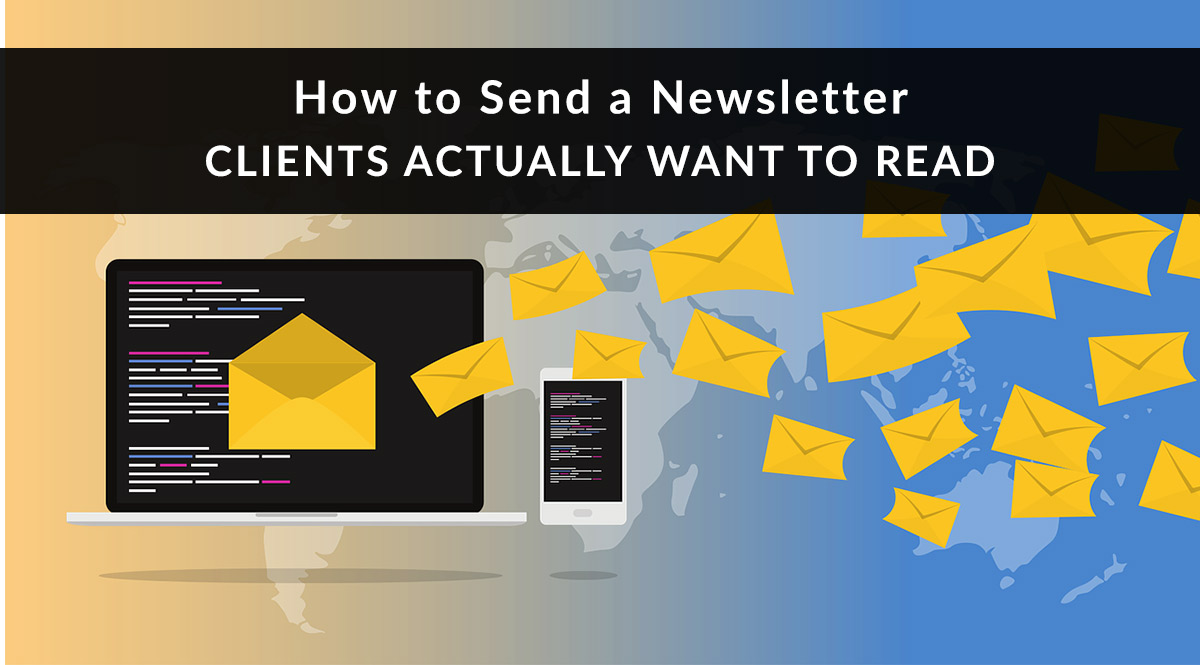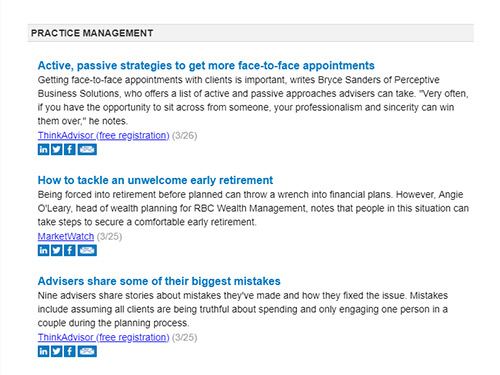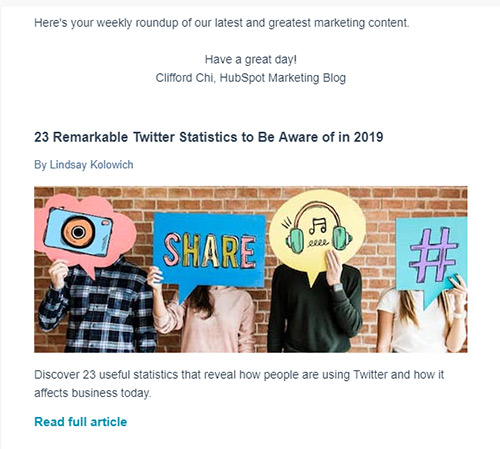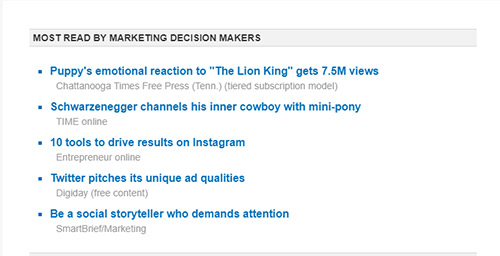
If you’re like us, your inbox is deluged every day with dozens (if not hundreds) of email newsletters.
Most are from brands, some are from influencers, and others are from companies we don’t even remember doing business with.
Here’s the thing – how many of those newsletters do you actually read? It’s faster to hit delete than it is to unsubscribe, so you can’t count on a low unsubscribe rate to indicate that you’re sending info clients want to read.
The gold standard is an email newsletter that clients can't wait to open, with content delivered in an easy-to-digest format. If that sounds easier said than done, never fear. Let’s go over what makes a killer newsletter…and how you can create one, or improve the newsletter you already send.
No time to read? Watch our video overview:
Why Email Newsletters?
If you’re not sure why you should put so much effort into your newsletter, let me show you. A whopping 80% of B2C marketers said email was their #1 marketing strategy, according to a 2019 study. Why? Because email is 40 times more effective for acquiring new customers than Facebook or Twitter, according to McKinsey.
Email is 40 times more effective for acquiring new customers than Facebook or Twitter.
When you think about it, it’s easy to see why email is still a killer app.
Social media networks come and go in terms of popularity, but no one stops checking their email. Unlike Facebook, which has the power to reduce your organic reach at a whim, you know you can always reach your clients and prospects through email.
Newsletter Tactic #1: Make It Personal
Yes, you’re writing a newsletter from an insurance agent. But you’re not a faceless corporation. You’re one person, doing what you can help people protect their families. Think of your newsletter as a one-to-one connection, a personal note aimed at one particular friend. If you were emailing a friend, you might include a joke, a shared reference, emojis, and use less formal language. Guess what? That’s all okay in your email newsletter, too.
Think of your newsletter as a one-to-one connection, a personal note aimed at one particular friend.
Here are a few tips for making your email newsletter more personal:
- Use contractions. In a personal context, no one says, “I am happy to assist you…”. Instead, you’d say something like “I’m happy to help.”
- Don’t use jargon. Imagine you’re talking to a neighbor or friend who isn’t in the insurance business. Would you say “IUL” and expect them to know what you’re talking about? Nope. You’d have to back up and explain it first, using language they’d understand.
- Sentence fragments are okay. In business writing (just like in high school essays), we use complete sentences. But in real life, we don’t speak that way. We say things like, “Never expected that to happen” or “Not my best idea.” While you don’t want to send a newsletter that replicates a text message, feel free to loosen up. Include more natural language, like sentence fragments.
Newsletter Tactic #2: Make It Relevant
This is tricky for us in the insurance space, because our clients are so diverse - they don’t all have the same backgrounds, experiences, and interests. So how can you make your emails relevant to them? It’s a challenge, but it can be done.
Start by sharing news and tips about the obvious subjects: personal finance and insurance. But don’t just paste in links to someone else’s article – explain why it matters. Give them some context. Even better if your context includes a bit of personality. Is this a source you love? An author you admire? A company you do business with? Have you taken this piece of advice yourself? What’s the best line in the article you’re sharing?
Don’t just paste in links to someone else’s article – explain why it matters.
Here are some tips for figuring out what’s relevant to your audience:
- Link tracking. Your email marketing software should track link clicks so you can see which of these subjects strike a chord. A week after you send the newsletter, log into your software and see which links intrigued your readers most. Offer more content on that subject in the future.
- Content requests. You already have a direct line to your subscriber – use it to ask them what they want to hear about. Include a question in your email, and encourage people to reply to you. This also builds a sense of connection between you, helping keep you top of mind.
- Feedback surveys. Don’t want a deluge of reply emails, but still want to solicit feedback? Create a Google Form survey and link to it from your email. Ask readers what they want more of and less of in the newsletter.
Newsletter Tactic #3: Make It Easy to Read
And by “easy to read,” we don’t mean a wall of text. Make it easy to skim. Make it easy to look up from the smartphone and see what the kids are doing, then glance back down and find their place again. Almost no one is going to read every word of your message. Given that, make it easy for them to find the part they do want to read.
So how is this achieved? By using subheads, images, and/or bullet points.
- Subheads. It may feel weird to use these in a newsletter that’s supposed to be personal, but it really helps to direct the reader’s attention. If you’re not talking about multiple topics that lend themselves to subheads, use short sentences as subheads to break up your newsletter text.

- Images. Including images can also help keep the reader’s attention focused. Granted, it’s more work to find them or create them, but if it keeps you top of mind with your clients, that’s a trade-off you should consider making. You don’t need a graphic designer or fancy infographics. A snapshot of you or your office taken with your cell phone is a good place to start.

- Bullet points. This works especially well if you’re passing on news or article links. Don’t bury them in a paragraph that’s hard to skim. Make a bullet point list of newsworthy points below your main message. Or, if you have a lengthy main message, try to turn it into a list article or pull points out that are easier to skim and digest in a bullet list.

Newsletter Tactic #4: Spend Time on Your Subject Line
Of course, all these tactics can’t help you if your subscriber never opens your email. So how do you get them to do that? With an enticing subject line. There are two main ways to make your subject line enticing: personalization, and an irresistible hook. As you’ve probably guessed, one is easier than the other.
Personalization
Personalization is one of the easiest ways to get people to open your emails. Most email marketing software (including Insureio) lets you add liquid fields to the subject line. Those liquid fields insert the recipient’s name as it sends your email.
Take a look at these two subject lines and guess which one recipients find more appealing:
- Mary, what financial worry keeps you up at night?
- The financial worry that keeps my clients up at night
Adding that name, as in the first example, makes it 26% more likely your recipient will open their email, according to Campaign Monitor. It creates a sense of intimacy, like you’re talking one-on-one. The second example doesn’t have that same feel.
Hook
This strategy is…a bit harder. You’re not a mind reader. How do you know what’s going to appeal to every member of your audience? You don’t, but you can rely on several types of subject lines that tend to do better than others. Over time, if you’re tracking your open rate, you can better judge what your subscribers respond to.
- Click-bait. Yes, it’s overdone – but it’s overdone because it works. Examples of click-bait subject lines might be: “Do NOT buy life insurance until you read this,” “What EVERYONE gets wrong about personal finance,” or “The insurance strategy that changes EVERYTHING.”

- Confessional. This one is similar to click-bait, but it’s using your personal experience as the bait. Your clients trust you because you’re an insurance expert. So when they see an email with a subject line like, “The worst insurance mistake I ever made,” they’re going to want to know what that’s about.

- Lists. Lists take advantage of our inherent curiosity. It’s hard not to see a list without wanting to click through and see what’s on it. Here are a few examples: “5 ways life insurance helps you during retirement,” “3 unexpected benefits of life insurance,” and “5 super-smart people who recommend annuities.”

- Questions. Like lists, questions are intriguing. We can’t help but answer them when they’re asked of us. Sometimes, that’s enough to get a recipient to click and open your email. Here are some samples: “What if I told you life insurance was 3X more affordable than you think?” and “Do you want an extra paycheck during retirement?”

That’s our look at how to send a newsletter clients actually want to read!
What are your best newsletter strategies? Tell us what works – or doesn’t work – in the comments.
